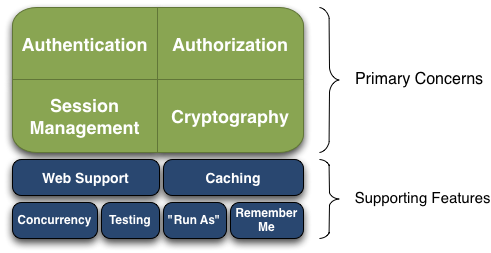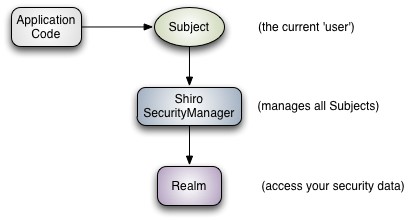Shiro.
Apache Shiro是一个功能强大且易于使用的Java安全框架可执行身份验证、授权、加密和会话管理。
通过Shiro易于理解的API,您可以快速、轻松地保护任何应用程序——从最小的移动应用程序到最大的web和企业应用程序。(可以在JavaSE中使用)

功能
- Authentication:身份认证、登录,验证用户是不是拥有相应的身份
- Authorization:授权,即权限验证,验证某个已认证的用户是否拥有某个权限,即判断用户能否进行什么操作,如
- 验证某个用户是否拥有某个角色,或者细粒度的验证某个用户对某个资源是否具有某个权限
- Session Management:会话管理,即用户登录后就是第一次会话,在没有退出之前,它的所有信息都在会话中 会话可以是普通的JavaSE环境,也可以是Web环境
- Cryptography:加密,保护数据的安全性,如
- 密码加密存储在数据库中,而不是明文存储
- Web Support:Web支持,可以非常容易的集成到Web环境
- Caching:缓存,比如
- 用户登录后,其用户信息,拥有的角色、权限不必每次去查,这样可以提高效率
- Concurrency:Shiro支持多线程应用的并发验证,如
- 在一个线程中开启另一个线程,能把权限自动的传播过去
- Testing:提供测试支持
- Run As:允许一个用户假装为另一个用户(如果他们允许)的身份进行访问
- Remember Me:记住我,即一次登录后,下次就无需登录了
架构(外部)

- Subject:应用代码直接交互的对象,也就是说Shiro的对外API的核心就是Subject,Subject代表了当前的用户,这个用户不一定是一个具体的人,与当前应用交互的任何东西都是Subject,如网络爬虫、机器人等,与Subject的所有交互都会委托给SecurityManager;Subject其实是一个门面,SecurityManager才是实际执行者
- Shiro SecurityManager:安全管理器,即所有与安全有关的操作都会与SecurityManager交互,并且它管理着所有的Subject,可以看出它是Shiro的核心,它负责与Shiro的其他组件进行交换,它相当于SpringMVC的DispatcherServlet的角色
- Realm:Shiro从Realm获取安全数据(如用户、角色、权限),就是说SecurityManager要验证用户身份,那么他需要从Realm获取相应的用户进行比较,来确定用户的身份是否合法;也需要从Realm得到用户相应的角色、权限,进行验证用户的操作是否能够进行,可以把Realm看出DataSource
架构(内部)

- Subject:任何可以与应用交互的 对象
- SecurityManager:相当于SpringMVC中的DispatcherServlet;是Shiro的心脏,所有具体的交互都通过SecurityManager进行控制,它管理者所有的Subject,且负责进行认证、授权、会话、及缓存的管理
- Authenticator:负责Subject认证,是一个扩展点,可以自定义实现;可以使用认证策略(Authentication Strategy),即什么情况下算用户认证通过了
- Authorizer:授权器,即访问控制器,用来决定主体是否有权限进行相应的操作;即控制着用户能访问应用中的那些功能
- Realm:可以有一个或多个的Realm,可以认为是安全实体数据源,即用于获取安全实体的,可以用JDBC实现,也可以是内存实现等等,由用户提供;所以一般在应用中都需要实现自己的Realm
- SessionManager:管理Session生命周期的组件,而Shiro并不仅仅可以用在Web环境,也可以用在普通的JavaSE环境中
- CacheManager:缓存控制器,来管理如用户、角色、权限等缓存的;因为这些数据基本上很少改变,放到缓存中后可以提高访问的性能
- Cryptography:密码模块,Shiro提高了一些常见的加密组件用于密码加密,解密等等
快速入门.
1、导入依赖.
<dependency>
<groupId>org.apache.shiro</groupId>
<artifactId>shiro-core</artifactId>
<version>1.6.0</version>
</dependency>
<!-- 日志使用 slf4j + log4j -->
<dependency>
<groupId>org.slf4j</groupId>
<artifactId>jcl-over-slf4j</artifactId>
<version>1.7.30</version>
</dependency>
<dependency>
<groupId>org.slf4j</groupId>
<artifactId>slf4j-log4j12</artifactId>
<version>1.7.30</version>
</dependency>
<dependency>
<groupId>log4j</groupId>
<artifactId>log4j</artifactId>
<version>1.2.17</version>
</dependency>springboot 默认 日志实现 是 logback
可以 在pom.xml 中关闭它
<!-- 关掉 springboot 默认的日志实现 logback --> <dependency> <groupId>org.springframework.boot</groupId> <artifactId>spring-boot-starter</artifactId> <exclusions> <exclusion> <artifactId>logback-classic</artifactId> <groupId>ch.qos.logback</groupId> </exclusion> </exclusions> </dependency>
2、 log4j.properties.
log4j.rootLogger=INFO, stdout
log4j.appender.stdout=org.apache.log4j.ConsoleAppender
log4j.appender.stdout.layout=org.apache.log4j.PatternLayout
log4j.appender.stdout.layout.ConversionPattern=%d %p [%c] - %m %n
# General Apache libraries
log4j.logger.org.apache=WARN
# Spring
log4j.logger.org.springframework=WARN
# Default Shiro logging
log4j.logger.org.apache.shiro=INFO
# Disable verbose logging
log4j.logger.org.apache.shiro.util.ThreadContext=WARN
log4j.logger.org.apache.shiro.cache.ehcache.EhCache=WARN3、shiro.ini.
[users]
# user 'root' with password 'secret' and the 'admin' role
root = secret, admin
# user 'guest' with the password 'guest' and the 'guest' role
guest = guest, guest
# user 'presidentskroob' with password '12345' ("That's the same combination on
# my luggage!!!" ;)), and role 'president'
presidentskroob = 12345, president
# user 'darkhelmet' with password 'ludicrousspeed' and roles 'darklord' and 'schwartz'
darkhelmet = ludicrousspeed, darklord, schwartz
# user 'lonestarr' with password 'vespa' and roles 'goodguy' and 'schwartz'
lonestarr = vespa, goodguy, schwartz
# -----------------------------------------------------------------------------
# Roles with assigned permissions
#
# Each line conforms to the format defined in the
# org.apache.shiro.realm.text.TextConfigurationRealm#setRoleDefinitions JavaDoc
# -----------------------------------------------------------------------------
[roles]
# 'admin' role has all permissions, indicated by the wildcard '*'
admin = *
# The 'schwartz' role can do anything (*) with any lightsaber:
schwartz = lightsaber:*
# The 'goodguy' role is allowed to 'drive' (action) the winnebago (type) with
# license plate 'eagle5' (instance specific id)
goodguy = winnebago:drive:eagle54、Quickstart.java.
重点看 流程 和 方法的作用
import org.apache.shiro.SecurityUtils;
import org.apache.shiro.authc.*;
//原来的路径是 import org.apache.shiro.ini.IniSecurityManagerFactory;
import org.apache.shiro.config.IniSecurityManagerFactory;
import org.apache.shiro.mgt.SecurityManager;
import org.apache.shiro.session.Session;
import org.apache.shiro.subject.Subject;
//原来的路径是 import org.apache.shiro.lang.util.Factory;
import org.apache.shiro.util.Factory;
import org.slf4j.Logger;
import org.slf4j.LoggerFactory;
public class Quickstart {
private static final transient Logger log = LoggerFactory.getLogger(Quickstart.class);
public static void main(String[] args) {
// The easiest way to create a Shiro SecurityManager with configured
// realms, users, roles and permissions is to use the simple INI config.
// We'll do that by using a factory that can ingest a .ini file and
// return a SecurityManager instance:
// Use the shiro.ini file at the root of the classpath
// (file: and url: prefixes load from files and urls respectively):
Factory<SecurityManager> factory = new IniSecurityManagerFactory("classpath:shiro.ini");
SecurityManager securityManager = factory.getInstance();
// DefaultSecurityManager securityManager = new DefaultSecurityManager();
// IniRealm iniRealm = new IniRealm("classpath:shiro.ini");
// securityManager.setRealm(iniRealm);
// for this simple example quickstart, make the SecurityManager
// accessible as a JVM singleton. Most applications wouldn't do this
// and instead rely on their container configuration or web.xml for
// webapps. That is outside the scope of this simple quickstart, so
// we'll just do the bare minimum so you can continue to get a feel
// for things.
SecurityUtils.setSecurityManager(securityManager);
// Now that a simple Shiro environment is set up, let's see what you can do:
// 获取当前用户对象
Subject currentUser = SecurityUtils.getSubject();
// 通过当前用户拿到session(shiro的)
Session session = currentUser.getSession();
session.setAttribute("someKey", "aValue"); // 存值
String value = (String) session.getAttribute("someKey"); // 取值
if (value.equals("aValue")) {
log.info("Retrieved the correct value! [" + value + "]");
}
// 测试当前用户 是否被认证
if (!currentUser.isAuthenticated()) {
// 通过 账号和密码 生成 令牌
UsernamePasswordToken token = new UsernamePasswordToken("lonestarr", "vespa");
token.setRememberMe(true); // 记住我
try {
currentUser.login(token); // 执行登录操作
} catch (UnknownAccountException uae) { // 用户不存在
log.info("There is no user with username of " + token.getPrincipal());
} catch (IncorrectCredentialsException ice) { // 密码不对
log.info("Password for account " + token.getPrincipal() + " was incorrect!");
} catch (LockedAccountException lae) { // 密码锁定
log.info("The account for username " + token.getPrincipal() + " is locked. " +
"Please contact your administrator to unlock it.");
}
// ... catch more exceptions here (maybe custom ones specific to your application?
catch (AuthenticationException ae) { // 认证失败
//unexpected condition? error?
}
}
//say who they are:
//print their identifying principal (in this case, a username):
// 获取当前用户的认证
log.info("User [" + currentUser.getPrincipal() + "] logged in successfully.");
//test a role:
if (currentUser.hasRole("schwartz")) {
log.info("May the Schwartz be with you!");
} else {
log.info("Hello, mere mortal.");
}
//test a typed permission (not instance-level)
// 粗粒度权限 *
if (currentUser.isPermitted("lightsaber:wield")) {
log.info("You may use a lightsaber ring. Use it wisely.");
} else {
log.info("Sorry, lightsaber rings are for schwartz masters only.");
}
//a (very powerful) Instance Level permission:
// 细粒度权限 指定
if (currentUser.isPermitted("winnebago:drive:eagle5")) {
log.info("You are permitted to 'drive' the winnebago with license plate (id) 'eagle5'. " +
"Here are the keys - have fun!");
} else {
log.info("Sorry, you aren't allowed to drive the 'eagle5' winnebago!");
}
//all done - log out!
// 注销
currentUser.logout();
// 结束
System.exit(0);
}
}Subject 主要涉及方法
Subject currentUser = SecurityUtils.getSubject();
Session session = currentUser.getSession();
currentUser.isAuthenticated()
currentUser.login(token);
currentUser.getPrincipal()
currentUser.hasRole("schwartz")
currentUser.isPermitted("lightsaber:wield")
currentUser.logout();SpringBoot中集成Shiro.
导入依赖
<dependency>
<groupId>org.apache.shiro</groupId>
<artifactId>shiro-spring-boot-web-starter</artifactId>
<version>1.6.0</version>
</dependency>三大对象
- Subject:用户
- SecurityManager:管理所有用户
- Realm:连接数据
1、编写配置类 ShiroConfig.
@Configuration
public class ShiroConfig {
// 1.创建 realm对象,需要自定义 -- realm
@Bean
public UserRealm userRealm(){
return new UserRealm();
}
// 2.DefaultWebSecurityManager -- securityManager
@Bean(name = "securityManager")
public DefaultWebSecurityManager getDefaultWebSecurityManager(@Qualifier("userRealm") UserRealm userRealm){
DefaultWebSecurityManager securityManager = new DefaultWebSecurityManager();
// 关联UserRealm
securityManager.setRealm(userRealm);
return securityManager;
}
// 3.ShiroFilterFactoryBean -- subject
@Bean
public ShiroFilterFactoryBean shiroFilterFactoryBean(@Qualifier("securityManager") DefaultWebSecurityManager defaultWebSecurityManager){
ShiroFilterFactoryBean bean = new ShiroFilterFactoryBean();
// 设置安全管理器
bean.setSecurityManager(defaultWebSecurityManager);
return bean;
}
}// 自定义的UserRealm 需要继承 AuthorizingRealm
public class UserRealm extends AuthorizingRealm {
// 授权
@Override
protected AuthorizationInfo doGetAuthorizationInfo(PrincipalCollection principalCollection) {
System.out.println("授权");
return null;
}
// 认证
@Override
protected AuthenticationInfo doGetAuthenticationInfo(AuthenticationToken authenticationToken) throws AuthenticationException {
System.out.println("认证");
return null;
}
}2、编写 controller 和 前端页面.
@Controller
public class MyController {
@RequestMapping("/")
public String index(Model model){
model.addAttribute("msg","shiro index");
return "index";
}
@RequestMapping("/list")
public String list(){
return "list";
}
@RequestMapping("/add")
public String add(){
return "add";
}
@RequestMapping("/update")
public String update(){
return "update";
}
}首页
<!doctype html>
<html xmlns:th="http://www.thymeleaf.org">
<head>
<meta charset="UTF-8">
<meta name="viewport"
content="width=device-width, user-scalable=no, initial-scale=1.0, maximum-scale=1.0, minimum-scale=1.0">
<meta http-equiv="X-UA-Compatible" content="ie=edge">
<title>Document</title>
</head>
<body>
<h1>首页</h1>
<mark th:text="${msg}"></mark>
<a th:href="@{/list}">跳到list</a>
</body>
</html>列表页
<!DOCTYPE html>
<html lang="en">
<head>
<meta charset="UTF-8">
<title>Title</title>
</head>
<body>
<ul>
<li>列表</li>
<li>列表</li>
<li>列表</li>
<li>列表</li>
</ul>
</body>
</html>添加 和 修改
<!DOCTYPE html>
<html lang="en">
<head>
<meta charset="UTF-8">
<title>Title</title>
</head>
<body>
<h1>add ...</h1>
</body>
</html>
<!DOCTYPE html>
<html lang="en">
<head>
<meta charset="UTF-8">
<title>Title</title>
</head>
<body>
<h1>update ...</h1>
</body>
</html>3、实现登录拦截.
在 ShiroConfig中 添加 过滤器
Shiro整合Thymeleaf.
引入依赖
<!-- 还需要 在ShiroConfig中 进行配置 -->
<dependency>
<groupId>com.github.theborakompanioni</groupId>
<artifactId>thymeleaf-extras-shiro</artifactId>
<version>2.0.0</version>
</dependency>在 ShiroConfig.java中添加 ShiroDialect
// 整合ShiroDialect : 用于整合 shiro thymeleaf
@Bean
public ShiroDialect getShiroDialect(){
return new ShiroDialect();
}页面导入命名空间
<html xmlns:th="http://www.thymeleaf.org"
xmlns:shiro="http://www.pollix.at/thymeleaf/shiro">标签使用说明
guest标签
<shiro:guest>
</shiro:guest>
用户没有身份验证时显示相应信息,即游客访问信息。
user标签
<shiro:user>
</shiro:user>
用户已经身份验证/记住我登录后显示相应的信息。
authenticated标签
<shiro:authenticated>
</shiro:authenticated>
用户已经身份验证通过,即Subject.login登录成功,不是记住我登录的。
notAuthenticated标签
<shiro:notAuthenticated>
</shiro:notAuthenticated>
用户已经身份验证通过,即没有调用Subject.login进行登录,包括记住我自动登录的也属于未进行身份验证。
principal标签
<shiro: principal/>
<shiro:principal property="username"/>
相当于((User)Subject.getPrincipals()).getUsername()。
lacksPermission标签
<shiro:lacksPermission name="org:create">
</shiro:lacksPermission>
如果当前Subject没有权限将显示body体内容。
hasRole标签
<shiro:hasRole name="admin">
</shiro:hasRole>
如果当前Subject有角色将显示body体内容。
hasAnyRoles标签
<shiro:hasAnyRoles name="admin,user">
</shiro:hasAnyRoles>
如果当前Subject有任意一个角色(或的关系)将显示body体内容。
lacksRole标签
<shiro:lacksRole name="abc">
</shiro:lacksRole>
如果当前Subject没有角色将显示body体内容。
hasPermission标签
<shiro:hasPermission name="user:create">
</shiro:hasPermission>
如果当前Subject有权限将显示body体内容
